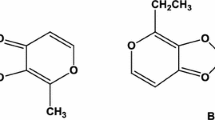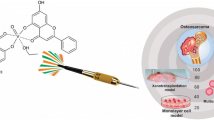Abstract
Background
Vanadium derivatives have been reported to display different biological effects, and in particular antineoplastic activity has been demonstrated in both in vivo and in vitro studies.
Purpose
To study the effect of two new organic vanadyl(IV) complexes (one with glucose, GluVO, and the other with naproxen, NapVO) in osteosarcoma cells.
Methods
UMR106 osteosarcoma cells and, for comparison, nontransformed MC3T3E1 osteoblasts were used. Proliferation and differentiation were assessed using the crystal violet assay and ALP specific activity, respectively. Morphological alterations were assessed by light microscopy. Lipid peroxidation was evaluated in terms of production of thiobarbituric acid-reactive substances (TBARS) and apoptosis was measured using annexin V. Extracellular regulated kinase (Erk) activation was investigated by Western blotting.
Results
Vanadium complexes caused morphological alterations and they strongly inhibited UMR106 cell proliferation and differentiation. In contrast, in MC3T3E1 cells, these vanadium derivatives had a relatively weak action. In UMR106 tumoral cells there was a significant increase in TBARS production. Both vanadium complexes induced apoptosis and activation of Erk. PD98059, an inhibitor of Erk phosphorylation, did not block the vanadium-induced antitumoral action. However, the antioxidants vitamins C and E abrogated the apoptosis and TBARS production induced by the vanadium complexes.
Conclusions
GluVO and NapVO exerted an antitumoral effect in UM106 osteosarcoma cells. They inhibited cell proliferation and differentiation. While the Erk cascade seems not to be directly related to the bioactivity of these vanadium derivatives, the action of both vanadium complexes with organic ligands may be mediated by apoptosis and oxidative stress.








Similar content being viewed by others
References
Aubrecht J, Narla RK, Ghosh P, Stanek J, Uckun FM (1999) Molecular genotoxicity profiles of apoptosis-inducing vanadocene complexes. Toxicol Appl Pharmacol 154:228
Barrio DA, Braziunas MD, Etcheverry SB, Cortizo AM (1997) Maltol complexes of vanadium (IV) and (V) regulate in vitro alkaline phosphatase activity and osteoblast-like cell growth. J Trace Elem Med Biol 11:110
Bishayee A, Roy S, Chatterjee M (1999) Characterization of selective induction and alteration of xenobiotic biotransforming enzymes by vanadium during diethylnitrosamine-induced chemical rat liver carcinogenesis. Oncol Res 11:41
Blázquez C, Galve-Roperh I, Guzmán M (2000) De novo-synthesized ceramide signals apoptosis in astrocytes via extracellular signal-regulated kinase. FASEB J 14:2315
Bradford M (1976) Rapid and sensitive method for quantitation of microgram quantities of protein utilizing the principle of protein-dye binding. Anal Biochem 72:248
Cortizo AM, Etcheverry SB (1995) Vanadium derivatives act as growth factor mimetic compounds upon differentiation and proliferation of osteoblast-like UMR106 cells. Mol Cell Biochem 145:97
Cortizo AM, Bruzzone L, Molinuevo S, Etcheverry SB (2000) A possible role of oxidative stress in the vanadium-induced cytotoxicity in the MC3T3E1 osteoblast and UMR106 osteosarcoma cell lines. Toxicology 147:89
Cortizo MS, Alessandrini JL, Etcheverry SB, Cortizo AM (2001) A vanadium/aspirin complex controlled release using a poly(beta-propiolactone) film. Effects on osteosarcoma cells. J Biomater Sci Polym Ed 12:945
Djordjevic C (1995) Antitumor activity of vanadium compounds. In: Sigel H, Sigel A (eds) Metal ions in biological systems, vol 31. Marcel Dekker, New York, p 595
D’Onofrio F, Le MQ, Chiasson JL, Srivastava AK (1994) Activation of mitogen activated protein (MAP) kinases by vanadate is independent of insulin receptor autophosphorylation. FEBS Lett 340:269
El-Naggar MM, El-Waseef AM, El-Halafawy KM, El-Sayed IH (1998) Antitumor activities of vanadium(IV), manganese(IV), iron(III), cobalt(II) and copper(II) complexes of 2-methylaminopyridine. Cancer Lett 133:71
Etcheverry SB, Cortizo AM (1998) Bioactivity of vanadium compounds in cells in culture. In: Nriagu JO (ed) Vanadium in the environment, part one. John Wiley and Sons, New York, p 359
Etcheverry SB, Crans DC, Keramidas AD, Cortizo AM (1997) Insulin-mimetic action of vanadium compounds on osteoblast-like cells in culture. Arch Biochem Biophys 338:7
Etcheverry SB, Williams PAM, Baran EJ (1997) Synthesis and characterization of vanadyl (IV) complexes with saccharides. Carbohydr Res 302:131
Etcheverry SB, Williams PAM, Barrio DA, Salice VC, Ferrer EG, Cortizo AM (2000) Synthesis, characterization and bioactivity of a new VO2+/aspirin complex. J Inorg Biochem 80:169
Etcheverry SB, Barrio DA, Cortizo AM, Williams PAM (2002) Three new vanadyl(IV) complexes with non-steroidal anti-inflammatory drugs (ibuprofen, naproxen and tolmetin). Bioactivity on osteoblast-like cells in culture. J Inorg Biochem 88:94
Etcheverry SB, Williams PAM, Sálice VC, Barrio DA, Ferrer EG, Cortizo AM (2002) Biochemical properties and mechanism of action of a vanadyl(IV)-aspirin complex on bone cell lines in culture. Biometals 15:37
Etcheverry SB, Barrio DA, Molinuevo MS, Cortizo AM (2002) Two new vanadyl(IV) complexes with potential antineoplastic effect on osteoblasts in culture. In: Khassanova L, Collery Ph, Maymard I, Khassanova Z, Ètienne JC (eds) Metal ions in biology and medicine, vol 7. John Libbey Eurotext, Paris, p 629
Evangelou A, Karkabounas S, Kalpouzos G, Malamas M, Liasko R, Stefanou D, Vlahos AT, Kabanos TA (1997) Comparison of the therapeutic effects of two vanadium complexes administered at low dose on benzo[a]pyrene-induced malignant tumors in rats. Cancer Lett 119:221
Granchi D, Cenni E, Ciapetti G, Savarino L, Stea S, Gamberini S, Gori A, Pizzoferrato A (1998) Cell death induced by metal ions: necrosis or apoptosis?. J Mater Sci 9:31
Gresser MJ, Tracey AS (1990) Vanadate as phosphate analogs in biochemistry. In: Chasteen ND (ed) Vanadium in biological systems. Kluwer Academic, Dordrecht, p 63
Huang C, Zhang Z, Ding M, Li J, Ye J, Leonard SS, Shen HM, Butterworth L, Lu Y, Costa M, Rojanasakul Y, Castranova V, Vallyathan V, Shi X (2000) Vanadate induces p53 transactivation through hydrogen peroxide and causes apoptosis. J Biol Chem 275:32516
Jackson JK, Min W, Cruz TF, Cindric S, Arsenault L, Von Hoff DD, Degan D, Hunter WL, Burt HM (1997) A polymer-based drug delivery system for the antineoplastic agent bis(maltolato)oxovanadium in mice. Br J Cancer 75:1014
Koopman G, Reutelingsperger CP, Kuijten GA, Keehnen RM, Pals ST, van Oers MH (1994) Annexin V for flow cytometric detection of phosphatidylserine expression on B cells undergoing apoptosis. Blood 84:1415
Krejsa CM, Nadler SG, Kavanagh TJ, Ledbetter JA, Schieven GL (1997) Role of oxidative stress in the action of vanadium phosphotyrosine phosphatase inhibitors. J Biol Chem 272:11541
Liasko R, Kabanos TA, Karkabounas S, Malamas M, Tasiopoulos AJ, Stefanou D, Collery P, Evangelou A (1998) Beneficial effects of a vanadium complex with cysteine, administered at low doses on benzo(alpha)pyrene-induced leiomyosarcomas in Wistar rats. Anticancer Res 18:3609
McCarthy AD, Etcheverry SB, Cortizo AM (1999) Advanced glycation endproduct-specific receptors in rat and mouse osteoblast-like cells: regulation with stages of differentiation. Acta Diabetol 36:45
Narla RK, Dong Y, Klis D, Uckun FM (2001) Bis(4,7-dimethyl-1,10-phenanthroline) sulfatooxovanadium(IV) as a novel antileukemic agent with matrix metalloproteinase inhibitory activity. Clin Cancer Res 7:1094
Nriagu JO (1998) History, occurrence and uses of vanadium. In: Nriagu JO (ed) Vanadium in the environment. John Wiley and Sons, New York, p 1
Ohkawa H, Ohishi N, Yagi K, Ohkawa H, Ohishi N, Yagi K (1979) Assay for lipid peroxides in animal tissues by thiobarbituric acid reaction. Anal Biochem 95:351
Okajima T, Nakamura K, Zhang H, Ling N, Tanabe T, Yasuda T, Rosenfeld RG (1992) Sensitive colorimetric bioassays for insulin-like growth factor (IGF) stimulation of cell proliferation and glucose consumption: use in studies of IGF analogs. Endocrinology 130:2201
Pandey SK, Théberge JF, Bernier M, Srivastava AK (1999) Phosphatidylinositol 3-kinase requirement in activation of the ras/C-raf-1/MEK/ERK and p70(s6 k) signaling cascade by the insulinomimetic agent vanadyl sulfate. Biochemistry 38:14667
Salice VC, Cortizo AM, Gomez Dumm CL, Etcheverry SB (1999) Tyrosine phosphorylation and morphological transformation induced by four vanadium compounds on MC3T3E1 cells. Mol Cell Biochem 198:119
Shisheva A, Shechter Y (1992) A cytosolic protein tyrosine kinase in rat adipocytes. FEBS Let 300:93
Stein Gs, Lian JB (1993) Molecular mechanism mediating proliferation/differentiation interrelationship during progressive development of the osteoblast phenotype. Endocr Rev 14:424
van Engeland M, Kuijpers HJH, Ramaekers FCS, Reutelingsperger ChPM, Schutte B (1997) Plasma membrane alterations and cytoskeletal changes in apoptosis. Exp Cell Res 235:421
Varga F, Luegmayr E, Fratzl-Zelman N, Glantschnig H, Ellinger A, Prinz D, Rumpler M, Klaushofer K (1999) Tri-iodothyronine inhibits multilayer formation of the osteoblastic cell line, MC3T3-E1, by promoting apoptosis. J Endocrinol 160:57
Wang YZ, Bonner JC (2000) Mechanism of extracellular signal-regulated kinase ERK-1 and ERK-2 activation by vanadium pentoxide in rat pulmonary myofibroblasts. Am J Respir Cell Mol Biol 22:590
Xia Z, Dickens M, Raingeaud J, Davis RJ, Greenberg ME (1995) Opposing effects of ERK and JNK-p38 MAP kinases on apoptosis. Science 270:1326–1331
Ye J, Ding M, Leonard SS, Robinson VA, Millecchia L, Zhang X, Castranova V, Vallyathan V, Shi X (1999) Vanadate induces apoptosis in epidermal JB6 P+ cells via hydrogen peroxide-mediated reactions. Mol Cell Biochem 202:9
Zamai L, Canonico B, Luchetti F, Ferri P, Melloni E, Guidotti L, Cappellini A, Cutroneo G, Vitale M, Papa S (2001) Supravital exposure to propidium iodide identifies apoptosis on adherent cells. Cytometry 44:57
Zhang Z, Huang C, Li J, Leonard SS, Lanciotti R, Butterworth L, Shi X (2001) Vanadate-induced cell growth regulation and the role of reactive oxygen species. Arch Biochem Biophys 392:311–320
Acknowledgements
M.S.M. is a fellow of the Colegio de Farmacéuticos de la Provincia de Buenos Aires, D.A.B. is a fellow of the CICPBA, A.M.C. is a member of the Carrera del Investigador CICPBA, and S.B.E. is a Member of the Carrera del Investigador CONICET, Argentina. This study was partially supported by CONICET (PIP 1044/98), UNLP and Colegio de Farmacéuticos de la Provincia de Buenos Aires, Argentina.
Author information
Authors and Affiliations
Corresponding author
Rights and permissions
About this article
Cite this article
Molinuevo, M.S., Barrio, D.A., Cortizo, A.M. et al. Antitumoral properties of two new vanadyl(IV) complexes in osteoblasts in culture: role of apoptosis and oxidative stress. Cancer Chemother Pharmacol 53, 163–172 (2004). https://doi.org/10.1007/s00280-003-0708-7
Received:
Accepted:
Published:
Issue Date:
DOI: https://doi.org/10.1007/s00280-003-0708-7




